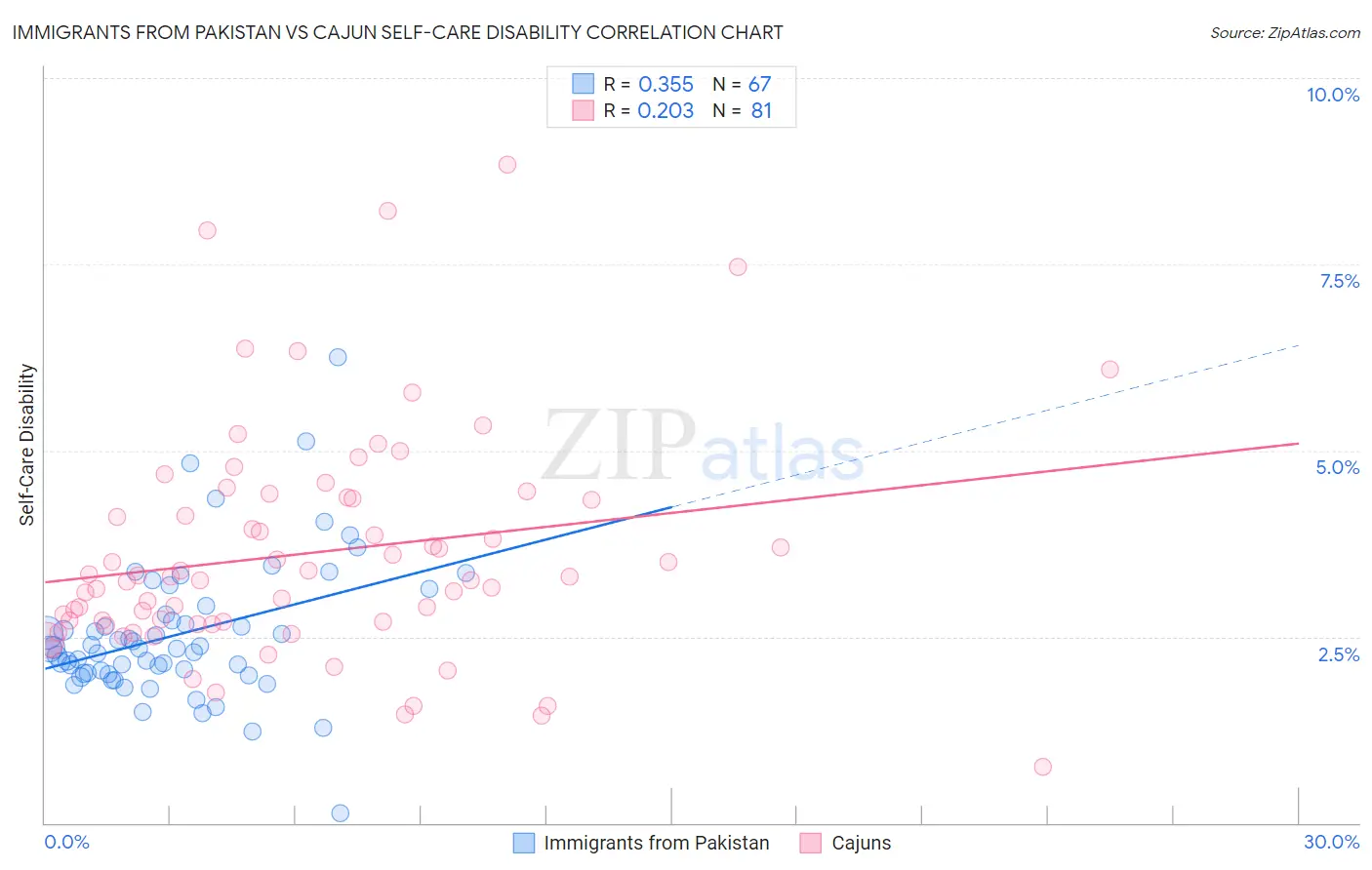Immigrants from Pakistan vs Cajun Self-Care Disability
COMPARE
Immigrants from Pakistan
Cajun
Self-Care Disability
Self-Care Disability Comparison
Immigrants from Pakistan
Cajuns
2.3%
SELF-CARE DISABILITY
99.8/ 100
METRIC RATING
43rd/ 347
METRIC RANK
2.9%
SELF-CARE DISABILITY
0.0/ 100
METRIC RATING
329th/ 347
METRIC RANK
Immigrants from Pakistan vs Cajun Self-Care Disability Correlation Chart
The statistical analysis conducted on geographies consisting of 283,675,484 people shows a mild positive correlation between the proportion of Immigrants from Pakistan and percentage of population with self-care disability in the United States with a correlation coefficient (R) of 0.355 and weighted average of 2.3%. Similarly, the statistical analysis conducted on geographies consisting of 149,634,207 people shows a weak positive correlation between the proportion of Cajuns and percentage of population with self-care disability in the United States with a correlation coefficient (R) of 0.203 and weighted average of 2.9%, a difference of 28.8%.

Self-Care Disability Correlation Summary
| Measurement | Immigrants from Pakistan | Cajun |
| Minimum | 0.14% | 0.75% |
| Maximum | 6.2% | 8.8% |
| Range | 6.1% | 8.1% |
| Mean | 2.5% | 3.6% |
| Median | 2.3% | 3.3% |
| Interquartile 25% (IQ1) | 2.0% | 2.7% |
| Interquartile 75% (IQ3) | 2.8% | 4.4% |
| Interquartile Range (IQR) | 0.78% | 1.7% |
| Standard Deviation (Sample) | 0.95% | 1.5% |
| Standard Deviation (Population) | 0.94% | 1.5% |
Similar Demographics by Self-Care Disability
Demographics Similar to Immigrants from Pakistan by Self-Care Disability
In terms of self-care disability, the demographic groups most similar to Immigrants from Pakistan are Immigrants from South Africa (2.3%, a difference of 0.040%), Immigrants from Uganda (2.3%, a difference of 0.050%), Norwegian (2.3%, a difference of 0.090%), Immigrants from Sudan (2.3%, a difference of 0.14%), and Czech (2.3%, a difference of 0.17%).
| Demographics | Rating | Rank | Self-Care Disability |
| Immigrants | Lithuania | 99.9 /100 | #36 | Exceptional 2.3% |
| Immigrants | Sweden | 99.9 /100 | #37 | Exceptional 2.3% |
| Immigrants | Eastern Africa | 99.9 /100 | #38 | Exceptional 2.3% |
| Immigrants | Bulgaria | 99.8 /100 | #39 | Exceptional 2.3% |
| Iranians | 99.8 /100 | #40 | Exceptional 2.3% |
| Immigrants | Sudan | 99.8 /100 | #41 | Exceptional 2.3% |
| Immigrants | Uganda | 99.8 /100 | #42 | Exceptional 2.3% |
| Immigrants | Pakistan | 99.8 /100 | #43 | Exceptional 2.3% |
| Immigrants | South Africa | 99.8 /100 | #44 | Exceptional 2.3% |
| Norwegians | 99.8 /100 | #45 | Exceptional 2.3% |
| Czechs | 99.8 /100 | #46 | Exceptional 2.3% |
| Jordanians | 99.7 /100 | #47 | Exceptional 2.3% |
| Immigrants | Malaysia | 99.7 /100 | #48 | Exceptional 2.3% |
| Latvians | 99.7 /100 | #49 | Exceptional 2.3% |
| Immigrants | Brazil | 99.7 /100 | #50 | Exceptional 2.3% |
Demographics Similar to Cajuns by Self-Care Disability
In terms of self-care disability, the demographic groups most similar to Cajuns are Hopi (2.9%, a difference of 0.21%), Black/African American (2.9%, a difference of 0.60%), Paiute (2.9%, a difference of 0.67%), Nepalese (3.0%, a difference of 0.75%), and Lumbee (3.0%, a difference of 0.87%).
| Demographics | Rating | Rank | Self-Care Disability |
| Comanche | 0.0 /100 | #322 | Tragic 2.9% |
| Seminole | 0.0 /100 | #323 | Tragic 2.9% |
| Cherokee | 0.0 /100 | #324 | Tragic 2.9% |
| Immigrants | Uzbekistan | 0.0 /100 | #325 | Tragic 2.9% |
| Paiute | 0.0 /100 | #326 | Tragic 2.9% |
| Blacks/African Americans | 0.0 /100 | #327 | Tragic 2.9% |
| Hopi | 0.0 /100 | #328 | Tragic 2.9% |
| Cajuns | 0.0 /100 | #329 | Tragic 2.9% |
| Nepalese | 0.0 /100 | #330 | Tragic 3.0% |
| Lumbee | 0.0 /100 | #331 | Tragic 3.0% |
| Kiowa | 0.0 /100 | #332 | Tragic 3.0% |
| Dutch West Indians | 0.0 /100 | #333 | Tragic 3.0% |
| Houma | 0.0 /100 | #334 | Tragic 3.0% |
| Immigrants | Azores | 0.0 /100 | #335 | Tragic 3.0% |
| Immigrants | Yemen | 0.0 /100 | #336 | Tragic 3.0% |